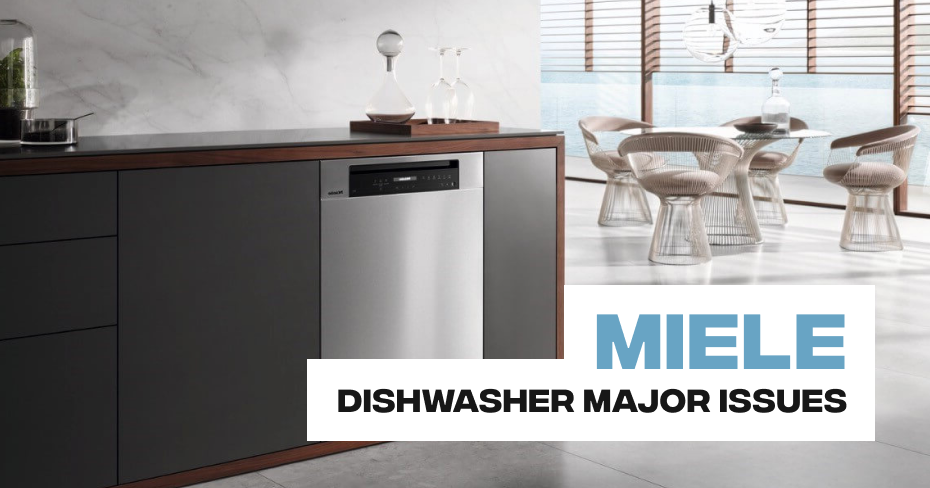
Miele Dishwasher Poor Cleaning Performance
Miele dishwashers are high-end appliances with a reputation for thorough and trustworthy cleaning. However, even the highest quality dishwashers may have a problem arise from time to time. Is your Miele dishwasher not cleaning dishes well? Problems like selecting the wrong cleaning cycle or overloading the dishwasher with too many dishes may cause performance issues.
How to Troubleshoot a Miele Dishwasher Not Cleaning Well
Poor cleaning results in a Miele dishwasher can have a variety of causes, from a simple solution to a faulty part that may need replacing. We will review the most common causes and possible solutions for Miele dishwasher troubleshooting.
Food Still Stuck On Dishes
When a Miele dishwasher not cleaning becomes a problem, one of the most obvious signs is food still stuck on dishes after the cleaning cycle is complete.
For cleaner dishes, follow these tips:
- Invest in a better detergent: Low-quality dishwasher detergents can cause poor dishwasher performance. For optimum cleaning power, try switching to a higher quality detergent.
- Clean the dishwasher filter:A Miele dishwasher not draining water can be a sign of a clogged or dirty filter. Filter problems can cause dirty water to drain slowly or incorrectly, leaving behind deposits of food particles on your dishes.
- Don’t overload the dishwasher: Putting too many dishes into the dishwasher at once may cause an overcrowding issue, limiting the amount of water and detergent that cleans your dishes. Ensure there is proper space between all items for proper cleaning.
Ensure Correct Settings Are Selected
Sometimes, the solution to a Miele dishwasher not cleaning may be as easy as a press of a button. If you’ve noticed less than optimal cleaning or dishes wet in Miele dishwasher, take a look at your Miele dishwasher service manual to review the types of programmed cycles. Make sure to select the appropriate one for your dishes. A stronger setting, like “Pots & Pans” can help remove heavily soiled dishes and utensils.
White Spots Left On Glass
Is your Miele dishwasher leaving white residue on your clean dishes? These unsightly white marks on your glassware are typically caused by hard water. Luckily, a hard water problem is generally resolved easily by adjusting the amount of detergent used and lowering the water temperature of the wash cycle. For extra washing and clear rinsing power, consider using a dishwasher rinse aid with each cycle.
Problem With Water Supply to Dishwasher
One of the most common causes of a Miele dishwasher not cleaning well is an issue with the dishwasher water supply.
These common water supply issues affect the performance of a dishwasher:
- Temperature: A proper hot water supply can be critical for a dishwasher’s performance. Make sure your dishwasher is properly connected to your home’s hot water heater, and that the hot water that it is providing is approximately 120℉.
- Amount: If your dishwasher is not provided with a proper water supply, it will struggle to clean your dishes. Check the dishwasher’s water inlet valve and ensure that it is allowing water to flow unobstructed, as needed. A faulty inlet valve may also make a loud banging sound during the dishwasher’s cycle. Typically, a faulty water inlet valve will need to be professionally replaced.
- Pressure: It is also critical for a dishwasher to have appropriate water pressure. This can be easily checked by running the tap at your kitchen sink and ensuring that the water pressure is not too low. If your water pressure is suspiciously low, a professional assessment will be needed.
Dishwasher Spray Arm Issues
“How to fix a dishwasher not cleaning” may be as easy as rearranging the items placed in the dishwasher. If the dishwasher spray arms are unable to rotate due to a large or tall item, it will severely limit the washing power of the spray arms. Before starting your dishwasher, ensure that the spray arms have plenty of room to rotate and are not obstructed by any object.
Dishwasher spray arms can also become clogged. Visually inspect the holes on the spray arms to ensure that they are not clogged. If you find a clog in a spray arm hole, a toothpick can be used to easily remove the debris. For spray arms that are broken, cracked, or completely clogged, a professional repair or replacement will be needed.
Schedule Appointment